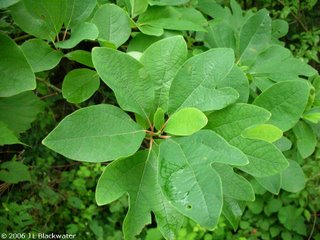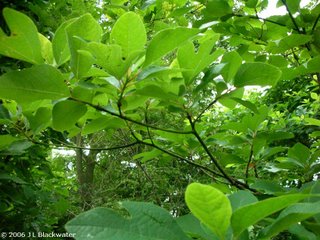Sassafras Trees and An Inconvenient Truth



Last weekend I was invited by my landlady to join her and a friend to see Al Gore’s movie, An Inconvenient Truth. I encourage everyone to see it. Better yet, bring along a friend.
The importance of this film does not lie with Al Gore or Davis Guggenheim or any of the other wonderful contributors; it lies in the act of disseminating this information in a clear, understandable, and meaningful way to Americans.
Apart from enjoying the film, the other really cool part of my evening was meeting my landlady’s friend. She lives in a house surrounded by trees, including a beautiful sassafras grove!
I never seem to have my camera when I really need it! However, after gazing up at the sassafras canopy for a while, I realized that there must be sassafras around the farm. Sure enough, yesterday I found some growing around the old silo.
What really tickles me about these trees is how much they remind me of the Pacific rhododendrons growing in the forests around Seabeck. They’re tall and slender, and the leaf arrangement is somewhat similar.
However, sassafras belongs to the Lauraceae family, while the Pacific rhododendron is a member of the Ericaceae family, which are both a part of the division Magnoliophyta - the flowering plants.
Plants is plants!

 Follow Jade Blackwater on Twitter
Follow Jade Blackwater on Twitter


Indeed! Al Gore really does a great job of making the information accessible and meaningful without bogging down in utter doom and gloom.
ReplyDeleteNeither is it boring - over all the film keeps itself moving along without losing the audience, the material is presented in an interested fashion, and I laughed more than once (when jokes were actually intended).
I hope you get a chance to see it!
I love the sassafras pictures. My brother has some sassafras trees in his wooded yard, and I've tried a couple of times to transplant one to my house. However, they have a long tap root and are difficult to successfully move to a new location. Both attempts have ended in failure, boo-hoo.
ReplyDeleteGreetings Carol! I haven't tried to transplant a sassafras before, but here is one option that you might like to try (at least, it works with rhododendrons and other plants):
ReplyDelete1) Find a low-haning branch, the younger the better (more pliable).
2) Bend the branch down to the earth, and secure it (try one of those "u" shaped stakes or a big ol' rock to keep the branch touching the earth without puncturing the wood).
3) Wait. tick-tock-tick-tock
4) Water occasionally.
5) After a few moons, you should be able to pull back the earth and see young roots sprouting. At this point, you'll want to cut the branch up a few inches before the new root sprouts (thanking the tree of course), and directly replant your cutting in its new location.
6) Be sure to water new cuttings for a while until their root systems mature.
Good luck!
JLB
I love the wild rhododendrons when they're in bloom. I much prefer their leggy shape the the squatty domestics.
ReplyDeleteI've been wanting to see An Inconvenient Truth. Glad to see it getting such good reviews.
P.S. I like the sound of the word "sassafras"
I hope you get a chance to see An Inconvenient Truth, it's definitely worth it!
ReplyDeleteAnd I totally agree - sassafras is a totally fun word!
Love this blog and very sentimental about sassafras, as my grandmother told me as a kid to chew on a tender stem for asthma. It tastes good!
ReplyDeleteGreetings PBSweeney! I'm so glad you are enjoying my blogs - I have a lot of fun here at Arboreality.
ReplyDeleteThat's a wonderful bit of wisdom from your grandmother, thank you for sharing!
Howdy Curt,
ReplyDeleteThank you for visiting my blogs - I'm glad that you enjoy them! Sassafras is really beautiful... I love your idea of a scrapbook! I was just considering something like that yesterday after picking a beautiful sweetgum leaf.
I've always pressed autumn leaves for their colors, but now that I find myself living somewhere with so many broad-leaf deciduous trees, I've realized that I could help create a sort of personal plant database if I began collecting green leaf specimens as well!
JLB